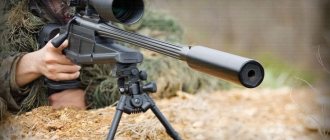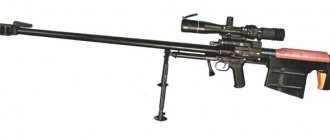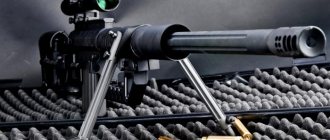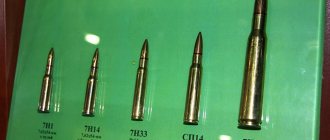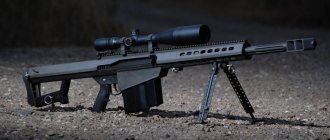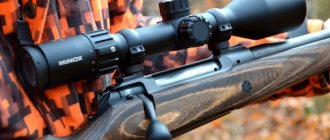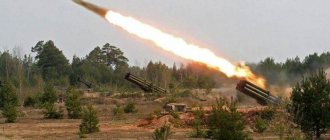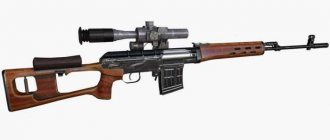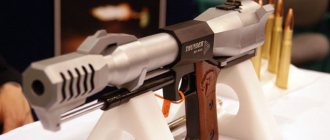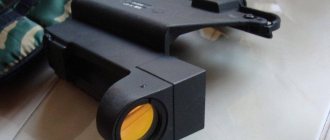Modern large-caliber sniper rifles have become, in fact, a return to the anti-tank rifles of the Second World War - the main difference from their “ancestors” is the presence of optical sights. As for combat missions, in addition to the destruction of armored vehicles, combat with enemy personnel was added, in addition, the main caliber was 12.7 mm.
Device for detecting sniper scopes "Antisniper"
24/7 device for detecting optical objects, in particular sniper scopes
The ANTISNIPER device is designed for visual observation of the terrain in day and night conditions, searching and detecting optical objects (television and photographic camera lenses, binoculars, optical sights, night vision devices, construction benchmarks with reflectors, etc.) and measuring the range to them . "ANTISNIPER" is also equipped with two laser target designators in the red and green ranges, which are used to illuminate the detected target and as additional resources for detecting optical objects in the visible range.
Antisniper
Modern large-caliber sniper rifles have become, in fact, a return to the anti-tank rifles of the Second World War - the main difference from their “ancestors” is the presence of optical sights. As for combat missions, in addition to the destruction of armored vehicles, combat with enemy personnel was added, in addition, the main caliber was 12.7 mm.
Tula large-caliber
A new class of weapons arose in the early 80s in the USA. The most famous 12.7 mm rifle was the M82 from the American company Barrett. Such weapons did not immediately gain trust among the sniper community, but by the early 90s, laudatory rumors reached Russian specialists. With the start of the first counter-terrorist operation in the Chechen Republic, the Russian Ministry of Internal Affairs required weapons of this particular class. The first to satisfy the needs of the security forces was the Tula Instrument Design Bureau (KBP). It offered the department its experimental B-94 rifle, which in 1996, after a number of modifications, was officially adopted by the Russian Ministry of Internal Affairs.
The rifle was developed under the leadership of V.P. Gryazeva. The main ammunition for the rifle was supposed to be standard machine gun cartridges with B-32 and BZT armor-piercing incendiary bullets. There was no sniper cartridge for such a system in Russia yet, and the Tula residents set about developing a special cartridge SPTs-12.7. It had an all-metal bronze bullet and an R100 accuracy rate at a distance of 300 m of no more than 12 cm. However, this cartridge was only an experimental one at that time, and “the design of the rifle itself was constantly being improved”
, as was directly stated in the technical description.
B-94 with a POS 13×60 sight in traveling condition forum.guns.ru
No less a problem for the Tula residents, as pioneers in this area, was the lack of an optical sight capable of withstanding the loads of such a powerful cartridge for a sniper weapon. The first experimental rifles were equipped with a PSO-1M2-2 sight with fourfold magnification. It is clear that shooting at long ranges with such a sight was not the most pleasant experience. At the same time, the sights of the PSO-1 series could not withstand large rounds of large-caliber cartridges. Later in Belarus, the BelOMO association developed its own version of the sight for the OSV-96 rifle (formerly V-94) based on the hunting variants of the PSO-1 family. According to the assurances of Belarusian developers, the POSP 12x50 sight could withstand the necessary loads.
To launch the rifle into mass production, the Pusk Research and Production Complex (RPC) (St. Petersburg) developed the first special 13-fold sight POS 13×60 weighing 3.5 kg. Such a massive product withstood the “blow” well when fired, but had too much weight. In turn, OSV-96 has already begun to be equipped with a much lighter POS 12x50 sight weighing 1.6 kg developed by the same St. Petersburg NPK. The 12x scope became standard for the rifle for a long time - until the Moscow company Dedal-NV developed a modern variable magnification scope DS 3-12×50 MST, which is still supplied with the rifle to this day.
The Tula rifle acquired its modern, recognizable appearance by 1999, and a year earlier it changed its name from B-94 to OSV-96. According to unofficial information, such a metamorphosis in the name change occurred due to export supplies to one of the foreign countries. In 2000, the updated rifle entered service with the Federal Penitentiary Service and the Ministry of Internal Affairs. Over time, the sniper cartridge also changed: they began to make the bullet from special steel, and the survivability of the barrel when firing such a cartridge from the OSV-96 rifle almost tripled compared to the B-32 and BZT cartridges. Not earlier than 2010, the Tula KBP, after much experimentation, launched the final version of the SPTs-12.7 cartridge into mass production.
OSV-96 karden.livejournal.com
Today OSV-96 is supplied to both foreign and domestic markets. The Tula large-caliber rifle has become one of the successful KBP projects of recent times. In the first decade of the 21st century alone, more than 700 of these rifles were produced, and now the count is already in the thousands. Serial licensed production of this model recently began in Vietnam and Iran.
Kovrov Army
Taking into account the combat experience of the first Chechen campaign, the Ministry of Defense of the Russian Federation, like the Ministry of Internal Affairs, set out to develop a large-caliber sniper rifle, opening development work (R&D) “Vzlomshchik-12.7” in 1998. The Tula KBP with the already well-known OSV-96 and the completely new VM-2000, as well as the Kovrov plant named after. Degtyareva (ZiD) with her SVN-98.
The SVN-98 sniper rifle (formerly known as SVN-12.7) was developed in 1998 under the leadership of V.I. Negrulenko. To successfully fulfill the requirements of the design and development work, the SVN-98 rifle, like the VM-2000, is made according to the bullpup design, which made it possible to implement a completely compact design with a long barrel. Another difference between these rifles and the OSV-96 was manual reloading with magazine feed. Thus, the Tula OSV-96 was used, rather, for comparative tests and had practically no chance of success, because the accuracy of bolt-action rifles is significantly higher than that of self-loading rifles.
In 1999, the Klimovsky Institute of Precision Engineering (TsNIITOCHMASH) began the development of an experimental 12.7SN sniper cartridge, which later received the index 7N34. During tests in 2000, when firing from the SVN-98 at a distance of 100 m, a pilot batch of cartridges showed satisfactory accuracy. The bullet of such a cartridge, unlike the Tula single-component one, consisted of a lead and steel core, similar to the bullet of the 7N1 rifle sniper cartridge. The accuracy of fire R100 declared for the 7N34 at a distance of 300 m does not exceed 8.5 cm. Serial production of large-caliber sniper cartridges began in Novosibirsk and Ulyanovsk in 2000.
Rifles V-94 and SVN-98 MasterRuzhie Magazine, No. 39, 1999
Thanks to the new cartridge, such a sniper complex has 1.5-2 times greater combat effectiveness compared to standard army sniper weapons. The muzzle energy of a large-caliber bullet is 6 times higher than that of a 7.62 mm caliber. When hitting a target, such a bullet hits it with 100% probability. The 7N34 cartridge was developed by V.N. TsNIITOCHMASH specialists. Shchitov, D.Yu. Semizorov and V.I. Chilikin.
If the cartridge was worked out quite quickly, then the modification of the weapon continued until 2003. All this time, the Kovrov rifle was a favorite and naturally became the winner of the competition. At the same time, in a short period of time it changed several names, becoming first KSVK (Kovrov large-caliber sniper rifle), then ASVK (large-caliber army sniper rifle), and eventually - the KORD army sniper rifle. Apparently, in this way they decided to return the Kovrov affiliation of the weapon to the name, because “KORD” is nothing more than an abbreviation of the phrase “Kovrov Gunsmiths-Degtyarevtsy”. All this time, only the index 6B7 assigned to the rifle remained unchanged.
ASVK rifle with SPP-M sight spezinform.ru
While the Ministry of Defense was conducting preliminary, field and military tests, the Federal Border Service of the Russian Federation (FPS, now the FSB PS) adopted the ASVK for service in 2001. In 2005, the Ministry of Internal Affairs did the same. Despite the actual completion of work on the Burglar-12.7 R&D back in 2004, the official adoption of the 6S8 complex (consisting of the 6V7 rifle, 7N34 cartridge, 1P71 and 1PN111 sights) into service with the Russian army took place only in 2013.
Ratnik-KORD-M
Since 2012, large-scale R&D “Ratnik” has been in full swing in Russian design bureaus on the equipment of the soldier of the future, in which there was also a place for a new large-caliber rifle. As part of the Ratnik-KORD-M R&D project, the 6V7 rifle underwent significant modernization, carried out by a group of specialists from the ZiD Design Center (PKC) under the leadership of E.V. Zhuravleva. ASVK-M received a barrel made of a new grade of steel, a large number of parts with extensive use of new materials and plastics, a muzzle brake of increased efficiency, an adjustable cheekpiece and butt plate, as well as many other improvements. All this made it possible to reduce the weight of the rifle to a record 11.2 kg. The sight (1P88-2) and cartridge (7N34M) were “upgraded”. By order of the Minister of Defense of the Russian Federation dated April 12, 2022 No. 226dsp, the 6V7M and 6V7M-1 army sniper rifles (with a shortened barrel) were adopted by the Russian army.
Rifles 6V7 and 6V7M zid.ru
The Tula competitor of the Kovrovites, the OSV-96 rifle, is also undergoing modernization. The completion of the work is scheduled for the end of 2022, as a result of which it is planned to significantly increase the accuracy and accuracy of fire, as well as refine the sniper cartridge. A large caliber has already entered the civilian market. The first sporting and hunting carbine in Russia was the 6V7-KOS; the Tula model is next.
Among the forgotten and experimental projects, it is worth recalling the Tula large-caliber rifle OTs-44, the development of which led to the creation of the now quite famous highly specialized rifle VKS.
The project of the Klimov 12.7-mm sniper rifle CP5 chambered for the SP15 cartridge, developed in the 2000s by order of the FSB, remained unrealized. More recently, the Izhevsk Kalashnikov concern presented the SV-18 rifle (aka KSV, Izh-1624) of 12.7 mm caliber, designed to use both domestic and NATO cartridges, and designed according to the bullpup design. Rifle characteristics
| Name | B-94 | OSV-96 | ASVK |
| Caliber | 12,7×108 | 12,7×108 | 12,7×108 |
| Cartridge | SPTs-12.7 | SPTs-12.7 | 7N34 |
| Weight with empty magazine and without optical sight, kg | 12,0 | 12,9 | 12,5 |
| Magazine capacity, cartridges | 5 | 5 | 5 |
| Length in firing position, mm | 1662 | 1746 | 1420 |
| Length in stowed position, mm | 1100 | 1154 | – |
| Width, mm | 125 | 132 | 150 |
| Height, mm | 304* | 190 / 425* | 260 |
| Barrel length, mm | 1000 | 1000 | 1000 |
| Sighting range, m | 1000 | 1300 | 1000 |
| Sighting range with optical sight, m | 1500 | 1800 | 1500 |
| Initial speed, m/s | 905 | 870 | 775-810 |
| Standard optical sight | POS13×60 | DS3-12×50 MST | 1P71 |
* — with optical sight
Sources:
- 12.7 mm sniper rifle V-94. Technical description and operating instructions V-94.00.000 TO
- 12.7 mm sniper rifle OSV-96. Operating manual OSV-96.00.000 RE
- 12.7 mm army sniper rifle "KORD". Operating manual 6B7 00 000 RE
Kovrov Army
Taking into account the combat experience of the first Chechen campaign, the Ministry of Defense of the Russian Federation, like the Ministry of Internal Affairs, set out to develop a large-caliber sniper rifle, opening development work (R&D) “Vzlomshchik-12.7” in 1998. The Tula KBP with the already well-known OSV-96 and the completely new VM-2000, as well as the Kovrov plant named after. Degtyareva (ZiD) with her SVN-98.
The SVN-98 sniper rifle (formerly known as SVN-12.7) was developed in 1998 under the leadership of V.I. Negrulenko. To successfully fulfill the requirements of the design and development work, the SVN-98 rifle, like the VM-2000, is made according to the bullpup design, which made it possible to implement a completely compact design with a long barrel. Another difference between these rifles and the OSV-96 was manual reloading with magazine feed. Thus, the Tula OSV-96 was used, rather, for comparative tests and had practically no chance of success, because the accuracy of bolt-action rifles is significantly higher than that of self-loading rifles.
In 1999, the Klimovsky Institute of Precision Engineering (TsNIITOCHMASH) began the development of an experimental 12.7SN sniper cartridge, which later received the index 7N34. During tests in 2000, when firing from the SVN-98 at a distance of 100 m, a pilot batch of cartridges showed satisfactory accuracy. The bullet of such a cartridge, unlike the Tula single-component one, consisted of a lead and steel core, similar to the bullet of the 7N1 rifle sniper cartridge. The accuracy of fire R100 declared for the 7N34 at a distance of 300 m does not exceed 8.5 cm. Serial production of large-caliber sniper cartridges began in Novosibirsk and Ulyanovsk in 2000.
Rifles V-94 and SVN-98
Thanks to the new cartridge, such a sniper complex has 1.5-2 times greater combat effectiveness compared to standard army sniper weapons. The muzzle energy of a large-caliber bullet is 6 times higher than that of a 7.62 mm caliber. When hitting a target, such a bullet hits it with 100% probability. The 7N34 cartridge was developed by V.N. TsNIITOCHMASH specialists. Shchitov, D.Yu. Semizorov and V.I. Chilikin.
If the cartridge was worked out quite quickly, then the modification of the weapon continued until 2003. All this time, the Kovrov rifle was a favorite and naturally became the winner of the competition. At the same time, in a short period of time it changed several names, becoming first KSVK (Kovrov large-caliber sniper rifle), then ASVK (large-caliber army sniper rifle), and eventually - the KORD army sniper rifle. Apparently, in this way they decided to return the Kovrov affiliation of the weapon to the name, because “KORD” is nothing more than an abbreviation of the phrase “Kovrov Gunsmiths-Degtyarevtsy”. All this time, only the index 6B7 assigned to the rifle remained unchanged.
ASVK rifle with SPP-M sight
While the Ministry of Defense was conducting preliminary, field and military tests, the Federal Border Service of the Russian Federation (FPS, now the FSB PS) adopted the ASVK for service in 2001. In 2005, the Ministry of Internal Affairs did the same. Despite the actual completion of work on the Burglar-12.7 R&D back in 2004, the official adoption of the 6S8 complex (consisting of the 6V7 rifle, 7N34 cartridge, 1P71 and 1PN111 sights) into service with the Russian army took place only in 2013.
Tula large-caliber
A new class of weapons arose in the early 80s in the USA. The most famous 12.7 mm rifle was the M82 from the American company Barrett. Such weapons did not immediately gain trust among the sniper community, but by the early 90s, laudatory rumors reached Russian specialists. With the start of the first counter-terrorist operation in the Chechen Republic, the Russian Ministry of Internal Affairs required weapons of this particular class. The first to satisfy the needs of the security forces was the Tula Instrument Design Bureau (KBP). It offered the department its experimental B-94 rifle, which in 1996, after a number of modifications, was officially adopted by the Russian Ministry of Internal Affairs.
The rifle was developed under the leadership of V.P. Gryazeva. The main ammunition for the rifle was supposed to be standard machine gun cartridges with B-32 and BZT armor-piercing incendiary bullets. There was no sniper cartridge for such a system in Russia yet, and the Tula residents set about developing a special cartridge SPTs-12.7. It had an all-metal bronze bullet and an accuracy rate of R100 at a distance of 300 m of no more than 12 cm. However, this cartridge was only experimental at that time, and “the design of the rifle itself was constantly being improved,” as was directly stated in the technical description.
B-94 with POS 13×60 sight in traveling condition
No less a problem for the Tula residents, as pioneers in this area, was the lack of an optical sight capable of withstanding the loads of such a powerful cartridge for a sniper weapon. The first experimental rifles were equipped with a PSO-1M2-2 sight with fourfold magnification. It is clear that shooting at long ranges with such a sight was not the most pleasant experience. At the same time, the sights of the PSO-1 series could not withstand large rounds of large-caliber cartridges. Later in Belarus, the BelOMO association developed its own version of the sight for the OSV-96 rifle (formerly V-94) based on the hunting variants of the PSO-1 family. According to the assurances of Belarusian developers, the POSP 12x50 sight could withstand the necessary loads.
To launch the rifle into mass production, the Pusk Research and Production Complex (RPC) (St. Petersburg) developed the first special 13-fold sight POS 13×60 weighing 3.5 kg. Such a massive product withstood the “blow” well when fired, but had too much weight. In turn, OSV-96 has already begun to be equipped with a much lighter POS 12x50 sight weighing 1.6 kg developed by the same St. Petersburg NPK. The 12x scope became standard for the rifle for a long time - until the Moscow company Dedal-NV developed a modern variable magnification scope DS 3-12×50 MST, which is still supplied with the rifle to this day.
The Tula rifle acquired its modern, recognizable appearance by 1999, and a year earlier it changed its name from B-94 to OSV-96. According to unofficial information, such a metamorphosis in the name change occurred due to export supplies to one of the foreign countries. In 2000, the updated rifle entered service with the Federal Penitentiary Service and the Ministry of Internal Affairs. Over time, the sniper cartridge also changed: they began to make the bullet from special steel, and the survivability of the barrel when firing such a cartridge from the OSV-96 rifle almost tripled compared to the B-32 and BZT cartridges. Not earlier than 2010, the Tula KBP, after much experimentation, launched the final version of the SPTs-12.7 cartridge into mass production.
OSV-96
Today OSV-96 is supplied to both foreign and domestic markets. The Tula large-caliber rifle has become one of the successful KBP projects of recent times. In the first decade of the 21st century alone, more than 700 of these rifles were produced, and now the count is already in the thousands. Serial licensed production of this model recently began in Vietnam and Iran.
